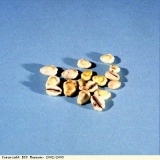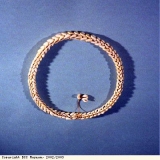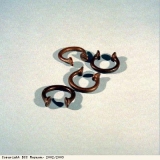The slave trade
Slavery existed in Africa, but it was not the same type of slavery that the Europeans introduced in the transatlantic slave trade. It was not as commercialised and was not on the same scale. Slaves within Africa lost the protection of their family and their place in society. They or their children, however, might eventually become part of their master’s family. In some cases, within three generations there was no social distinction between people of slave origins and those of free origins. This was very different to the system of chattel slavery, which Europeans introduced. In this system, the status of the slave was passed down through the generations. Once a person was enslaved, their children would also be slaves for their entire lives. This was not usually the case with slaves within Africa.
The treatment of slaves within Africa varied widely. Ottobah Cuguano, a freed slave, remembered slaves as being ‘well fed … and treated well.’. Olaudah Equiano, another freed slave, noted in his autobiography that slaves might even own slaves themselves. While some slaves worked in government administration, others were agricultural labourers and many died in the gold and salt mines of West Africa.
Africans usually enslaved ‘other’ African people, not their own particular ethnic, or cultural group. Slaves were taken as prisoners of war, or enslaved in payment for debt or as punishment for crime. These slaves supplied the slave trade to North Africa. They also supplied the ‘Oriental’ slave trade from East Africa to areas such as India. But, as the demand for slaves grew from Europeans, warfare and raids to get slaves and the kidnapping of individuals increased.
The slave trade across the Sahara desert to North Africa began in the 7th century AD. Slaves were sold to traders in such (modern) countries as Morocco, Libya and Egypt and to the North African empires in the Mediterranean and southern Europe. People in these areas wanted female slaves for domestic servants and male slaves to serve as soldiers, guards and in administrative posts. Slaves were at first bought (and kidnapped) from Europe as well as sub-Saharan Africa, but Africa became the main source. It is estimated that in the 17th century, a period of relatively heavy slave trading, about 10,000 enslaved Africans a year were traded north from West Africa. This slave trade with North Africa and its empire expanded in the 19th century. At the same time, slave trading was being abolished by most Western European countries.
The transatlantic slave trade began developing from the 15th century, after the Portuguese started exploring the west coast of Africa. They found that they could buy slaves there. At first they bought enslaved Africans as domestic servants. In 1550 there were 10,000 African slaves in the city of Lisbon, Portugal, out of a total population of 100,000. There were 5,000 Africans in Seville, Spain, in 1565. Most of them were slaves, but some were free and included one who was a judge. European people continued to move to the Caribbean islands and mainland America to what was called the ‘new world’ . The land there was developed for farming, and more workers were needed to work on the new plantations. This need for workers was met by buying more and more enslaved Africans. The number of enslaved people available in Africa increased to meet the demand on the plantations.
Enslaved Africans were also exported from ports on the east coast of Africa to the Middle East and India. The numbers involved were small until the late 18th century, when French and Brazilian merchants began buying slaves from this area. In the first half of the 19th century, almost 30,000 enslaved Africans a year were exported from the eastern coast of Africa.
The area that is now South Africa was settled by the Dutch, who introduced the use of slaves. But there was a difference here in South Africa. The small number of Dutch who came to live there were eager to remain on good terms with the many Africans around them. They therefore did not enslave the local African population or import many enslaved Africans from the west coast of Africa. Instead, they bought slaves in from the east across the Indian Ocean, from what is now Indonesia and Malaysia.
Pictured here are brass bracelet-shaped objects called ‘manillas’. They were made in Bristol and elsewhere for trade with West Africa. They were brass shapes which were accepted there as a form of currency. Manillas would have been used by the Bristolian traders, along with other goods, to purchase enslaved people. Also shown here is a belt made from a type of shell called cowrie shell, it is from the Congo, in West Africa. Millions of small, white cowrie shells were traded across Africa from the Indian Ocean, and taken to West Africa by European traders. The shells were used as money, and as decoration to show the wealth and influence of the owner. Like the brass manillas, these shells might have also been used to trade for slaves. The map, also pictured here, shows some of the routes that the traders took across Africa to trade for items like the brass shapes and the cowrie shells.





